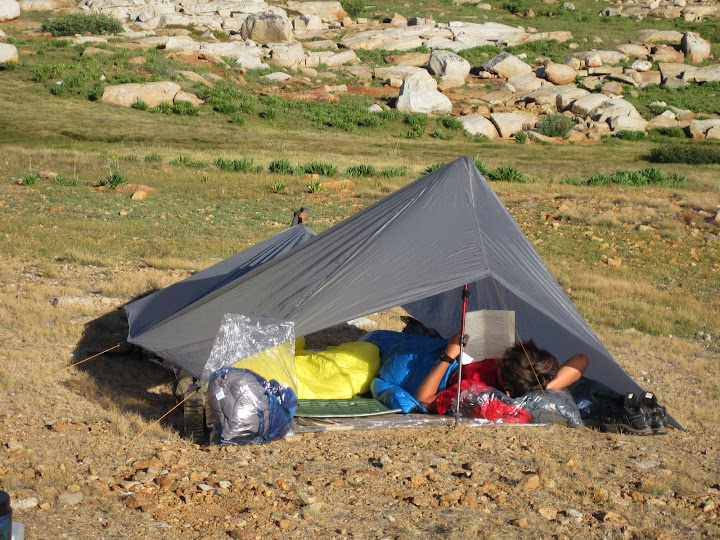Hobbes, I am getting on toward geezerhood, and ultralight is the means necessary for me to succeed in trips. So I am very interested in your setup. I just purchased an Ursack "all white" and aluminum liner to lighten the bear safety setup.
What is your sleeping setup -- mattress, quilt, etc. And how do you successfully keep covered using the quilt? What do you use for rain protection: tent, parka, etc?
Well, I'm 56, so I don't know if that counts for geezerhood. I've always enjoyed long(ish) day hikes in the 15+- mile range - especially to fish remote streams & lakes. I've got pretty good cardio, and usually run 20+ miles/week, including a 10k weekend run, and sometimes a 1/2 marathon.
However, I've always hated being constrained by carrying a pack - especially with any weight. And it's not like I'm a lightweight - I'm 6'1", 180lbs and have been surfing for over 40 years. IOW, I have a lot of upper body strength, so it's not a function of physical ability, but rather the psychological challenge of using technology to solve a problem. And that is, why carry anything that you don't need to get through two conditions: wet and cold.
The key to dealing with cold is spending money on loft - I'm talking 800 fill power at a minimum, and 900+ FP if you find/afford it. Knowing what I needed to deal with expected max minimum summertime lows in the mid-upper 20s (anything colder and I will either not go or hike out), I figured out the amount of down (in ounces) I needed to get through the night.
I also learned how to sew, because purchasing any retail item(s) is going to necessarily entail something overbuilt simply to deal with customer expectations ie no one wants to spend $ on some flimsy thing that is going to need periodic attention. The kit I used was this one from Thru-Hiker:
http://thru-hiker.com/kits/quilt_kit.php (top line kit @ $219). Note also the high tech M90 fabric that is coated with a durable water repellent (DWR). There is enough fabric to create the quilt wide enough so that it can tuck under you to trap body heat. As many may know, compressed down underneath you (as in a sleeping bag) does absolutely nothing, so it's wasted weight.

I also have a Montbell 800FP vest that I can wear to help get through cold(er) night - like when Guitar is windy & cold. This is what I have:
http://www.amazon.com/Mont-Bell-Alpine-Light-Down/dp/B00F2Y9PGO. In addition, I have beanie to trap air from my head.
So that's my sleep set up. For a pad, and this might be a little extreme for many/most, I have a cut down Ridgerest that extends from my hips to my shoulders:
http://www.cascadedesigns.com/therm-a-rest/mattresses/trek-and-travel/ridge-rest-solite/productI'm into failproof simplicity, so I don't want any failures with inflatables - that's what can doom you on cold ground. I can deal with a handful of rough nights out on this pad, since my #1 goal is to get through 7-8hrs of night to enjoy 16hrs of daylight.
Any long time surfer knows all about hypothermia - you don't have to be in snow to experience the effects. In fact, any ambient temp below 96 is going to induce a chill over time with respect to the amount of activity one is doing. That's why you can get hypothermia in tropical water - 72-78 ain't gonna do you any good if you're wet and not moving enough. So the key is to stay dry & reduce the chance of getting wet.
To that end, I built DIY low-profile tarps - solo & 2-man - that are probably around 15-20% oversized in both length and width. The solo weighs 15oz with guy lines & stakes, while the 2-man is 1lb, 5oz. Here's a picture of my son chilling in the 2-man:

That ground cover is polycro - the same material as window insulation:
http://www.amazon.com/Duck-281065-Indoor-Window-120-Inch/dp/B000NHW2Z6 Also, those are turkey baking bags holding our clothes. (The yellow quilt is a synthetic I built on my first attempt.)
For rain gear, I use this poncho:
http://www.amazon.com/Frogg-Toggs-FTP171...rog+togs+ponchoIt's not that hardy, but my intention is to hole up during rain, not hike. Besides, if there's lightning, I don't want to be hiking anyway. The poncho can also supplement the tarp by wrapping it over the foot section of the quilt, even though the tarps have been through monsoon rains and have stayed perfectly dry inside.
For cooking, I use this esbit burner from TD
http://www.traildesigns.com/stoves/caldera-cone-system with a Ti pot and use freezer bag techniques covered here:
http://www.trailcooking.com/trail-cooking-101/freezer-bag-cooking-101/Last, but not least, since my gear is so light, my DIY pack doesn't have to carry more than 20 lbs. Less than 20 lbs means I don't need a frame. Frameless means my pack can use really light, 1st run, high quality, high strength silnylon, along with the folded sleeping pad as the backpad:

That's a BV450 tucked inside, but I also recently got the Ursack Allwhite to use in areas not specifically prohibited eg Yosemite, Rock Creek (Miter), Rae Lakes (Center basin) & Dusy basin.
This basic setup weighs 7.4 lbs - including the 10 essentials and other knicknacks. My fishing gear (2 rods - one spinner, one fly) weighs 1.3, so I'm @ 8.7 before food/water. For a 4 night trip, I'll take 4lbs of food (avg 150 cal/oz), so add 4 lbs and and avg of 16oz of water between dips & drinks + 1/2 lb of sunscreen, DEET, soap, toothpaste and fuel, which together adds another 5.5 lbs. All told, I hit the trail with around 14.2lbs. When exiting, I'm @ 10.2lbs.
That's why I usually plan on hiking 15-20 miles out on my last day. I'm essentially carrying nothing, so it's really just like a long(ish) day hike. That's about it - I'm sure there will be questions, so this should be enough info to serve as an anchor post.